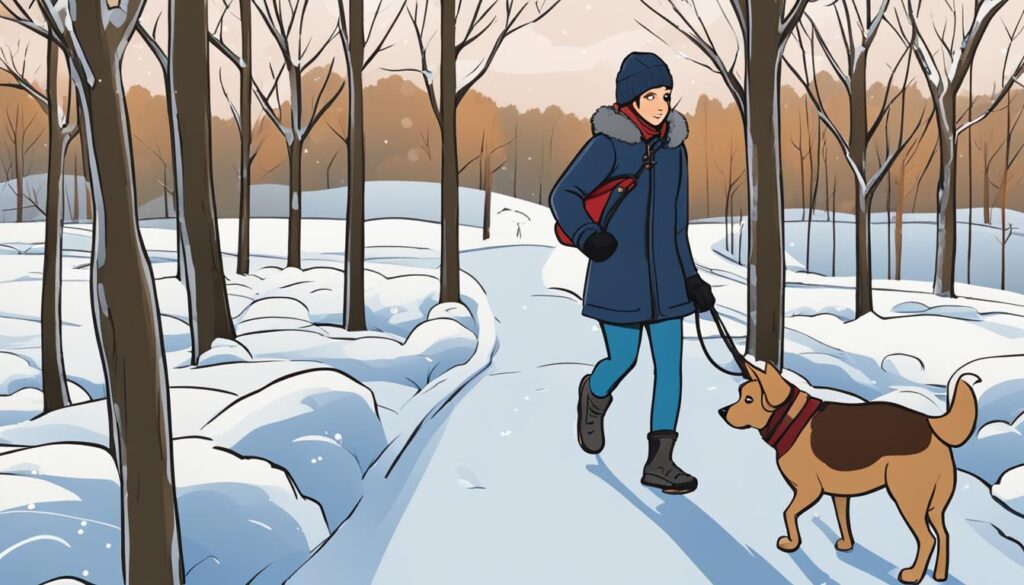Winter is a beautiful season for dog walks, but it can also pose several risks to your furry friend’s health. As a responsible pet owner, it’s crucial to take necessary precautions to ensure your dog’s safety and well-being during the colder months. In this section, we’ll cover essential winter dog walking tips that will help keep your dog protected and healthy in cold weather.
The cold weather can be challenging not only for humans but also for pets. Dogs need exercise even in the winter months, but extra precautions must be taken to avoid any health risks that may arise. Cold weather pet care is essential during winter dog walking, and there are several things you can do to keep your canine friend safe and healthy. Let’s look at some of the essential winter dog walking safety tips.
Key Takeaways:
- Winter dog walking requires extra precautions to ensure your furry friend’s safety.
- Cold weather pet care is crucial during winter dog walking.
- Regular exercise is necessary for dogs, even in the winter months.
- Protective gear such as dog boots is essential to prevent frostbite on your dog’s paws.
- Stay alert for signs of hypothermia in your dog during winter walks.
Protecting Your Dog’s Paws in Cold Weather
When taking your furry friend out for a winter walk, protective gear is essential to keep them safe and comfortable. In cold weather, the most vulnerable part of your dog’s body is its paws. Fortunately, there are numerous options for protective gear, including canine winter boots.
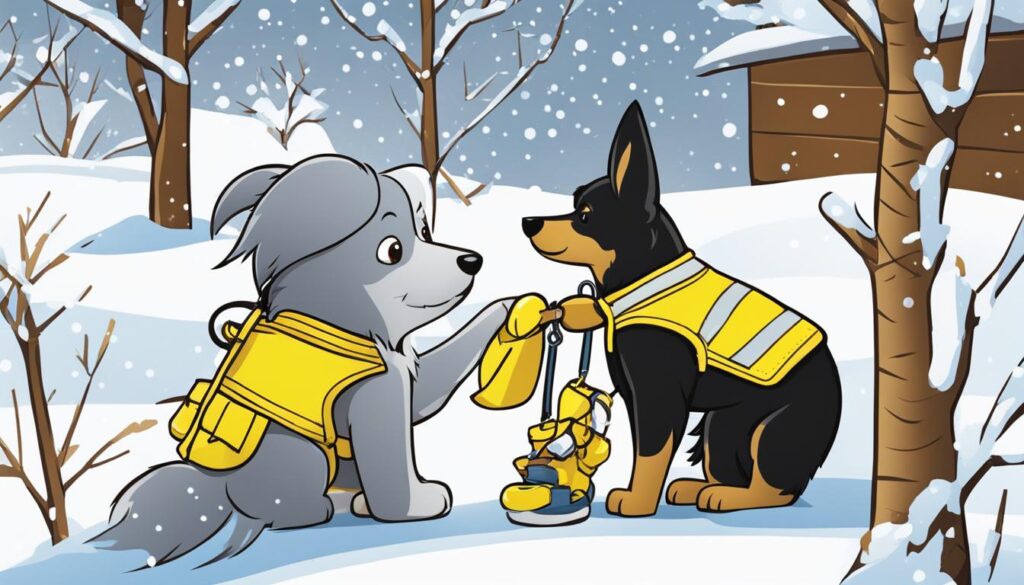

Winter boots are designed to keep your dog’s paws warm and dry, while also providing a layer of protection against salt and other chemical de-icers that can cause irritation or burns. It’s important to find the right fit to ensure maximum comfort and protection.
If you’re considering purchasing winter boots for your dog, be sure to read reviews and consult with your veterinarian for recommendations. You can also use paw balms or waxes to create a protective barrier on your dog’s paws before going out for a walk. Just remember to wipe their paws clean after the walk to remove any chemicals or salt residue.
Frostbite prevention is also crucial during winter walks. Signs of frostbite include discoloration, swelling, and blisters on your dog’s paws. To prevent frostbite, limit the time spent outside during extremely cold weather, and keep your dog moving to improve circulation. If your dog is showing signs of frostbite, take them to a veterinarian immediately.
Ensuring Your Dog’s Health in Winter
Winter can be a challenging season for dogs, with the cold weather presenting various health risks. To keep your furry friend healthy during the winter months, follow these essential tips:
Keeping Dogs Warm Outdoors
One of the most important things to consider when walking your dog in winter is keeping them warm. Just like humans, dogs can get hypothermia and frostbite from extended exposure to cold temperatures. To prevent this, make sure your dog wears a warm coat or sweater and consider using booties to protect their paws from the cold.
Best Practices for Dog Walking in Winter
When walking your dog in the winter, there are a few best practices to keep in mind:
- Limit walks to shorter durations or distance to avoid prolonged exposure to the cold
- Choose the warmest part of the day for walks, usually in the afternoon
- Walk on cleared pathways to avoid ice and snow buildup on your dog’s paws
- Bring a towel to dry off your dog’s paws and body after the walk
Winter Diet and Health
In the winter, it’s important to adjust your dog’s diet to their activity level. If they’re less active due to cold weather, consider reducing their food intake to avoid weight gain. Additionally, make sure your dog stays hydrated by providing plenty of fresh water, as dehydration can still occur in winter.
Another essential aspect of your dog’s health in winter is regular checkups with your veterinarian. They can help you determine if any changes are necessary to maintain your dog’s health during the winter season.
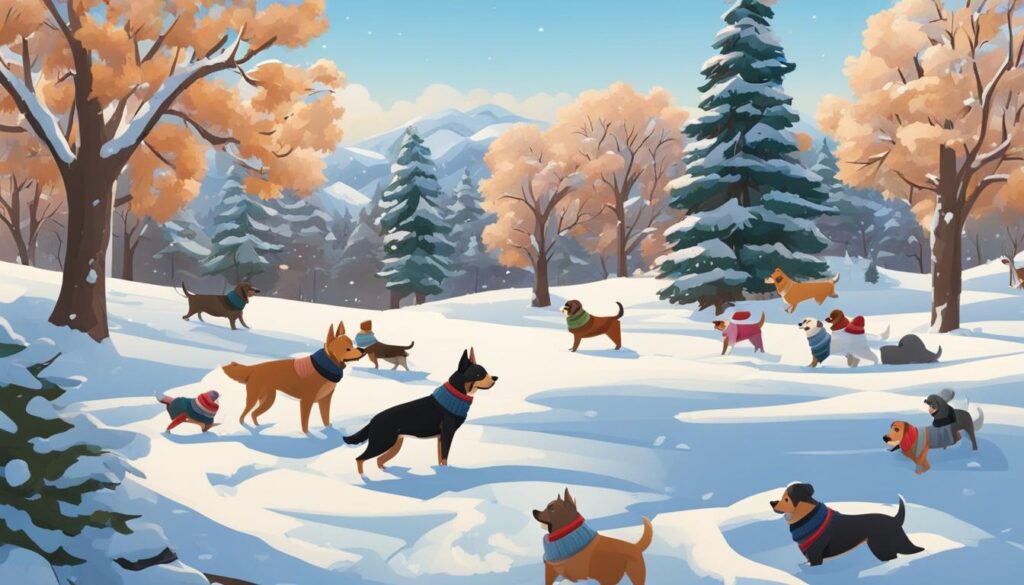

Managing Snowy Dog Walks
Walking your dog in snowy conditions can be a fun and exciting experience, but it’s important to take precautions to ensure your furry friend stays safe and comfortable. Here are some essential tips for managing snowy dog walks:
- Dress appropriately: Just like you, your dog needs to be bundled up in cold weather. Consider getting them a winter coat or sweater to help them stay warm during the walk.
- Protect their paws: Snow and ice can be harsh on your dog’s paws. Consider getting them protective booties or applying a paw balm to help prevent frostbite and ice buildup between their toes.
- Choose your route wisely: When walking your dog in snow, be mindful of icy patches and deep snowdrifts. Stick to plowed sidewalks and paths if possible to avoid injury.
- Keep them leashed: A snowy landscape can make it difficult for your dog to see and smell as they normally would. Keeping them leashed will prevent them from running off or getting lost in the snow.
- Watch for signs of discomfort: Your dog may not be able to communicate their discomfort in the same way you can. Keep an eye out for signs such as shivering or lifting their paws, and be ready to cut the walk short if needed.
By following these tips, you can make the most of your snowy dog walks while ensuring your dog’s safety and comfort.
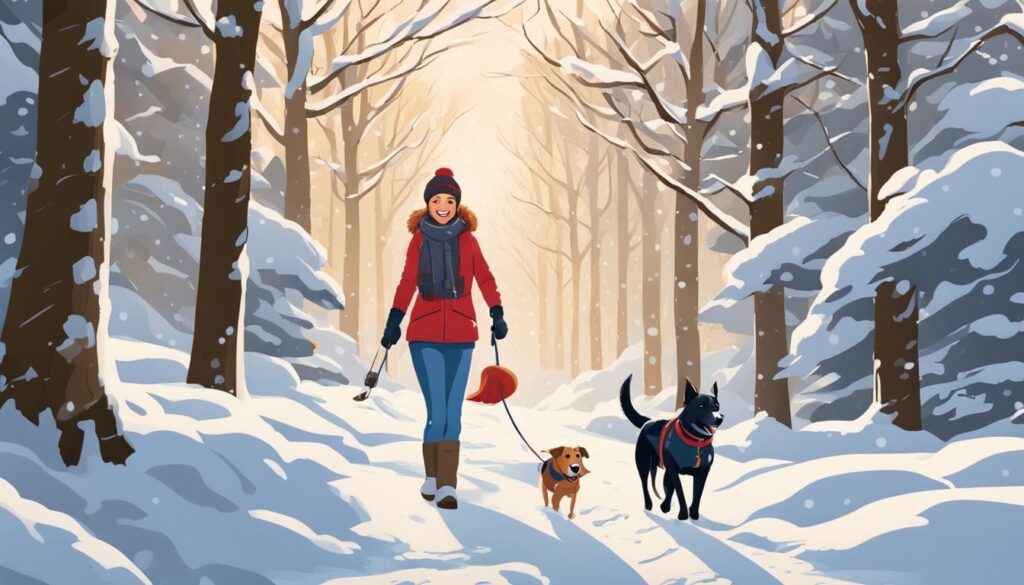

Essential Winter Dog Walking Gear
When it comes to winter dog walking, having the right gear is crucial. Not only does it keep your furry friend safe and comfortable, but it also ensures that you can enjoy the great outdoors without worrying about the cold weather. Here are some must-have items for your winter dog walking arsenal:
| Item | Description |
|---|---|
| Canine winter boots | Protect your dog’s paws from the cold and prevent frostbite with dog boots. Look for boots with a non-slip sole and adjustable straps for a comfortable fit. |
| Warm coat or sweater | Keep your dog warm and cozy with a winter coat or sweater. Look for insulated options with a water-resistant outer layer to protect against snow and sleet. |
| Reflective gear | Visibility is key during winter walks, especially in low-light conditions. Invest in reflective collars, harnesses, and leashes to keep you and your dog safe on the roads. |
| Water and snacks | Stay hydrated and energized during your winter dog walks with water and snacks. Pack a portable water bowl and high-energy treats to keep your dog fueled and happy. |
Aside from these essentials, there are a few other items you may want to consider. A first aid kit can come in handy in case of any accidents or injuries, while a towel or blanket is useful for wiping off any snow or mud your dog may pick up during the walk.
Remember, preparation is key when it comes to winter dog walking. By having the right gear, you can ensure a safer and more enjoyable experience for both you and your furry friend. Stay warm, stay safe, and have fun!
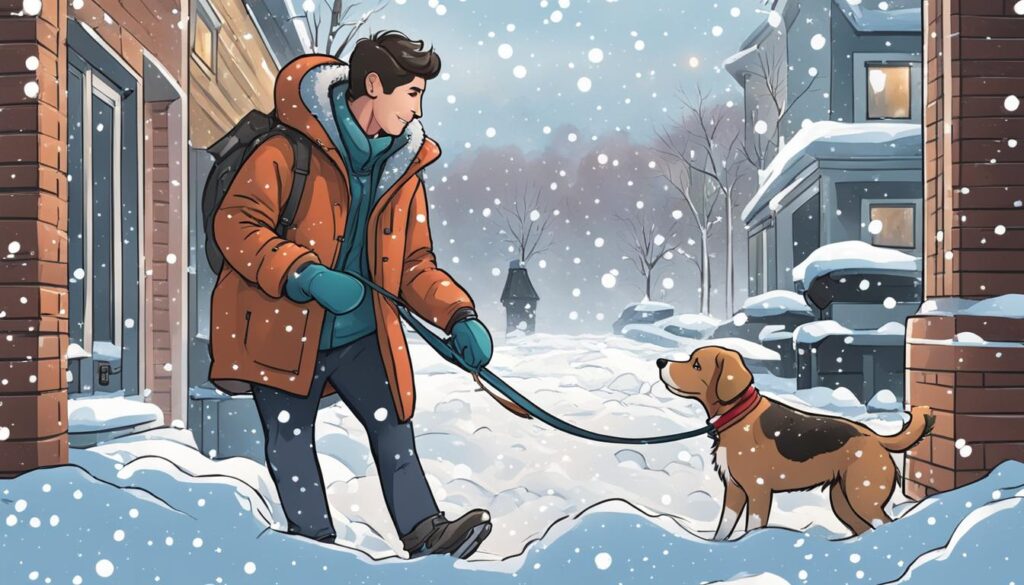

Conclusion
Winter dog walking can be a challenging but rewarding experience for you and your furry friend. By following the essential tips outlined in this article, you can ensure your dog stays safe and healthy during the cold weather. Remember to protect their paws with appropriate gear and maintain their health with regular vet check-ups and sufficient exercise.
Invest in High-Quality Winter Dog Walking Gear
The right gear can make all the difference in ensuring a successful winter dog walking experience. From canine winter boots to waterproof jackets, investing in high-quality gear can keep your dog warm, dry, and comfortable during walks. Don’t forget to dress yourself appropriately too for added comfort on long walks.
Stay Safe Out There
Winter weather can be unpredictable. Always check weather forecasts before setting out, and be prepared for unexpected shifts in temperature. Avoid walking during extreme weather conditions such as snowstorms and icy conditions. And remember to use caution when walking on slippery surfaces, especially if your dog is prone to pulling or tugging.
Enjoy the Experience
Winter dog walking can be a special bonding experience for you and your dog. Take the time to enjoy the scenery, smell the crisp winter air, and embrace the unique challenges of winter walks. With the right preparation, gear, and mindset, you can make the most of your time outdoors with your furry friend.
FAQ
What are some essential winter dog walking tips?
Essential winter dog walking tips include protecting your dog’s paws, ensuring their health, managing snowy walks, and having the right winter dog walking gear.
How can I protect my dog’s paws in cold weather?
You can protect your dog’s paws in cold weather by using protective gear such as dog boots and ensuring they don’t stay out for too long in freezing temperatures to prevent frostbite.
What should I do to maintain my dog’s health during winter?
To maintain your dog’s health during winter, keep them warm outdoors with appropriate clothing, follow best practices for dog walking in winter, and pay attention to their overall well-being.
How do I handle snowy dog walks?
To handle snowy dog walks, be cautious of slippery surfaces, consider using a leash and harness for better control, and clear a path for your dog if necessary.
What gear do I need for winter dog walking?
Essential gear for winter dog walking includes proper winter clothing for your dog, a leash and collar or harness, waste bags, reflective gear for visibility, and any additional items specific to your dog’s needs.

